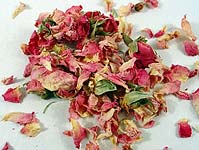|
The sweet smell
of
petal power |

It takes two tons of rose petals to produce 200
millilitres of rose oil |
|
SIMON DE BURTON
reports on the happy lot of Cawthorpe Hall, near Bourne, where it
takes a two-ton crop to produce its rosewater and oil. |
Next time you see a fallen rose petal, pick it up and try to
imagine how many it would take to make a ton. Ozric Armstrong knows the
answer - a lot.
In 1989, Armstrong decided to establish a rose plantation on eight acres
of land beside his home, Cawthorpe Hall, near Bourne in Lincolnshire, for
the simple reason that little else thrives in the area's heavy clay soil.
He and his wife Chantal now tend an impressive spread of 2,000 roses, and
harvest the flowers from early summer until the first frosts. After each
morning's picking, they boil the petals in a Heath Robinson-like still
made from a caterer's cooking pot and an ex-Coal Board condenser, to
produce headily fragrant rosewater and highly concentrated rose oil.
The Armstrongs' annual production of rosewater is about 2,000 litres,
while only 200-300 millilitres of oil can be extracted from the year's
harvest. To get those amounts, two tons of petals have to be distilled. To
put that into perspective, a standard wheelbarrow load weighs four to five
pounds.
Most of the roses on the plantation are of the Roseraie de l'Ha˙ variety,
because it is hardy and produces large numbers of highly scented blossoms
in regular flushes, although the Armstrongs do grow Louise Odier (which
also makes fine rose jam) and Bulgarian Kazanlik (aka Professeur Emile
Perrot). This is the most fragrant and oily variety, but the blossoming
season lasts only three weeks and it is also the least suited to the
area's climate.
The genteel life of a rose farmer is a strong contrast to Armstrong's
pre-retirement career as a civil engineer on road and pipeline projects in
Africa and the Middle East. After returning to Britain, he attended a
commercial horticulture course one day a week for two years before setting
up the plantation.
"During the season it is a seven-days-a-week job, and out of season there
is pruning, manuring and weeding to be done," he says.
"Roseraie de l'Ha˙ is a very tough variety, which is important, as we run
the plantation on an almost entirely organic basis and therefore don't use
any chemicals or sprays against aphids or other insects. We rely on the
balance of nature being maintained by birds, ladybirds and hoverfly. This
is very important to aromatherapists, who insist on the rose oil being as
pure as possible.
"Our main enemies are moles, which tunnel underneath and can damage the
root system, as well as rabbits and deer, which nibble at the bushes -
although it doesn't really matter if the petals are a bit chewed as they
all end up as pulp in the still."
Apart from insects and moles, other natural influences can affect a rose
harvest. The Armstrongs' chief picker, Ghislaine Raby, starts work at 6 a
m to catch the blossoms as they begin to open with the first touches of
sunlight, but a stiff breeze is all it takes to blow away the precious
scent. If the petals have been subjected to a shower, they are likely to
remain tightly shut. And if a bee has got there first, forget it - once
pollinated, a rose stops smelling.
The harvesting process, which involves deftly tweaking the blossom at its
base to remove it cleanly from the bush, is surprisingly quick. Within an
hour of being picked, the roses are undergoing the distillation process -
any longer and they would lose their moisture, and subsequently most of
their perfume.
After that, the Armstrongs are left with the pleasurable task of bottling
their products and selling them to retailers, aromatherapists and
customers of their b & b business. These visitors invariably leave
Cawthorpe with a sample of rose water, having been wooed by the scent of
the freshly cut blossoms that are a feature of every room.
Ozric and Chantal Armstrong can be contacted on 01778
423830 or at www.rosewater.co.uk.
Reproduced from the Gardening section of The Daily
Telegraph, Saturday 13th August 2005.
Return to Cawthorpe

Go to:
Main Index Villages
Index
|